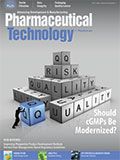News
Article
Pharmaceutical Technology
Clarifying Industry’s Concerns Over Regulation of Drug Device Combinations
Author(s):
Will EMA’s draft guideline clarify questions about the assessment of drug device combinations in relation to the EU medical devices regulation?
Editor’s Note: This article was published in Pharmaceutical Technology Europe’s July 2019 print issue.
Europe’s pharmaceutical industry, especially its growing number of companies developing and marketing drug device combinations (DDCs), has been expecting a lot from a draft European Medicines Agency (EMA) guideline (1) on the implementation of a new EU medical devices regulation (MDR).
The guideline, issued in late May 2019, almost exactly a year before MDR comes into force, was anticipated to fill some major information gaps, particularly about how safety certification organizations, called Notified Bodies (NBs), would assess the quality, safety, and performance of new DDCs.
More fundamentally, the industry wants a holistic approach to be taken in the evaluation by regulators of the drug and device in DDCs (2,3). This is particularly the case with single, integral products designed for the drug and device to be used exclusively in a specific, non-reusable combination, such as a prefilled syringe or prefilled autoinjector.
This approach would necessitate the drug and device, especially their interaction, being assessed together by a regulatory authority-either the EMA for products with EU-wide distribution or national competent authorities (NCAs), usually medicines licensing agencies, in EU member states. There are fears that the NBs involvement in assessment will undermine an integrated approval system (2,3).
Industry expectations
The MDR is replacing the 1993 EU directive on medical devices (MDD), while a separate regulation on in-vitro diagnostics due to come into force in 2022 will replace a 1998 directive on companion diagnostics. The degree of satisfaction within the industry with the 26-page MDR guideline will become clear after a three-month consultation, which ends 31 August 2019, leading to the finalization of the document before the MDR starts being implemented on 26 May 2020.
So far, it appears that at least parts of the industry, especially those developing and producing biopharmaceutical device combinations, who are most affected by the regulation, are not happy with the guideline. They are particularly concerned about an absence of detail in the report about how its article 117, requiring certain higher-risk DDCs to be assessed by NBs, will operate.
“The guideline is not giving us all the information we need,” says Veronique Debaut, regulatory affairs manager at European Biopharmaceutical Enterprises (EBE), part of the Brussels-based European Federation of Pharmaceutical Industries and Associations (EFPIA). “We still need more clarification on certain issues, such as what will the process be for the assessment of DDCs by Notified Bodies,” she told Pharmaceutical Technology Europe.
Furthermore, lack of clarity in the guideline is arousing concerns within the pharma industry about whether the regulatory infrastructure for implementing MDR will be sufficiently well prepared for its enforcement next May. As a result, DDC producers may have to postpone market launches of new products.
Enough Notified Bodies?
A major anxiety is that an inadequate number of NBs will have been designated by the European Union to conduct MDR assessments when the regulation comes into force. Due to stricter criteria being applied when certification organizations are selected as NBs for assessment work under the new regulations covering both medical devices and companion diagnostics, the total of NBs could drop by as much as a third compared with the numbers conducting assessments under the existing legislation.
While NB numbers are decreasing, more devices and diagnostic products are having to be assessed by NBs because of a widening of the scope of the new legislation. Furthermore, the NBs will have to check whether individual products comply with a much longer list of quality, safety, and performance requirements than those in the existing MDD.
NBs will be needed not just to certify new products but some classes of existing medical devices already on the market, some containing pharmaceuticals. Those unable to be recertified because of a scarcity of NBs may have to be withdrawn from the market.
NBs will typically take three to nine months to complete a product recertification, while even more time will be needed to complete a new MDR certification, according to MedTech Europe, the trade association for medical device and diagnostics manufacturers (4).
“At the current pace of preparation, the new regulatory system will not be ready early enough to absorb this extra workload,” said Serge Bernasconi, MedTech Europe’s chief executive, in an open letter to the European Commission in April 2019 (4). “As of May 2020, thousands of medical devices will become non-compliant and will not be authorized for use by surgeons, doctors, hospitals, and patients.”
By May 2019, only two NBs-UK-based BSI Assurance and Tuev Sued of Germany-have been designated for MDR work, while the European Commission estimated that by the end of the year a total of 12 would have been designated. “This is way too late (and) insufficient,” Bernasconi protested. “[It] gives no guarantee that Notified Bodies would have enough capacity to ensure continued regulatory approval of devices by May 2020.”
Ironically, EMA wants to use the guideline to ensure a smoothly operating regulatory system for controlling DDCs at a time when they will be accounting for a growing proportion of new drug approvals, especially at the EU level. Out of 593 marketing authorization applications for medical products approved by EMA between January 2010 and mid-2018, almost a quarter had device components. The majority of these devices were prefilled syringes or pens, inhalers, nasal sprays, tablet delivery systems, and advanced therapy medicinal products (ATMPs), such as autologous cultured chondrocytes embedded in a biodegradable matrix or scaffold. In 2017, DDCs accounted for around a third of EMA drug approvals, a proportion which was about two-thirds higher than in the previous year.
“[DDCs] will likely become more commonplace as technology develops,” says the guideline (1). “The availability of commercialized devices with automated functions is increasing [which] may benefit patients with regular and long-term dosing requirements in an outpatient setting.”
Harmonizing regulations
Harmonization is a key objective of MDR. It has been introduced as a regulation because EU regulations have to be transposed directly into national legislation without alteration. Directives, which provide the basis for existing EU rules on medical devices and in-vitro diagnostics, can be modified by EU member states, which has led to inconsistencies in the way they are applied across the EU.
The numbers of general safety and performance requirements (GSPRs) listed in the MDR’s Annex 1 are considerably higher than in its MDD counterpart due to a need to ensure that the MDR’s rules are more clearly aligned with a broader set of international harmonized standards and guides. These include those of the International Organization for Standardization (ISO) and the International Council for Harmonization (ICH) of pharmaceuticals.
While the medical device directive has 94 essential requirements divided into 13 clauses, the MDR has 178 GSPRs spread over 23 clauses. The guideline stresses that its “core precept” is that the regulatory authority will have the main responsibility for evaluating “the device-specific aspects of safety and performance relevant to the quality, safety, and efficacy of the medicinal product,” while the NB would, “as applicable, assess the relevant GSPRs.”
Within the marketing authorization application (MAA) dossier, data on the two aspects would be given separately. One section would contain information on the drug-specific quality and safety attributes related to the device. Another section would comprise relevant information on compliance with the MDR’s Annex 1, including the NB’s opinion of GSPR compliance.
A major issue with the interaction between the device and drug, whose assessment will effectively be the responsibility of the regulatory authority, will be the compatibility of the device’s materials with the medicine. The guideline lists incompatibility dangers from materials such as moisture, microbial contamination, vapour phase permeation, and extractable and leachable substances, such as lubricants and label adhesives.
The guideline does not include advice on how the NBs should make their assessments. “The processes by which a NB derives their opinion are not within the scope of this guideline,” it says. But it does recommend that the results of the NB’s assessment should be presented as a technical summary report on the grounds that this would avoid duplication with evaluations by the regulatory authority.
EBE and EFPIA have suggested in three papers, the first of which was issued in January 2018, various ways in which certain DDCs may not need specific NB assessments, especially if a risk-based approach is adopted by regulators (2,3,5). These could include combinations based on platform technologies or wellâknown technologies.
“Where a device is also a component of an already marketed medicinal product, there is opportunity to leverage prior knowledge and previous NB opinion without the need for further oversight,” the two organizations said in a joint reflection paper on MDR’s Article 117, issued July 2018 (2).
In a reflection paper on quality control strategies for DDCs issued in June 2019 but before publication of the MDR guideline, EBE argued that existing global harmonized guidelines such as those of ISO and ICH are sufficient for operating an adequate quality control strategy for combination products (5).
“The fundamental principles underpinning drug product component and device component guidance are broadly aligned,” EBE said. “Since the building blocks for product development are already in place, adapting and clarifying Module 3 (MAA quality) content for DDC products should be possible with minimal disruption to existing ‘best practice’.”
Discussions between industry and EMA on the finalization of the MDR guideline are likely to centre on how much current quality principles and processes used by DDC manufacturers need to be changed to deal with the likely longer-term growth in DDC products.
References
1. EMA, Draft Guidance 259165/2019, Guideline on Quality Requirements for Drug-Device Combinations (Amsterdam, 29 May 2019).
2. EBE and EFPIA, Reflection paper. An Industry Perspective on Article 117 of the EU Medical Devices Regulation and the Impact on how Medicines are Assessed (Brussels, 12 July 2018).
3. EBE, Reflection paper. Medicinal Product Incorporating a Drug Delivery Device Component: An Industry Perspective on the EU Marketing Application Technical Requirements, Regulatory Review Process and Post-Approval Device Related Change Assessment (Brussels, 15 January 2018).
4. MedTech Europe, “Open Letter on the Implementation and Readiness Status of the New Medical Devices Regulation,’’ Letter to Jyrki Katainen, Vice-President, Jobs, Growth, Investment and Competitiveness, European Commission, 15 April 2019.
5. EBE, Reflection paper, Medicinal Product Incorporating a Drug Delivery Device Component: An Industry Perspective on Delivery of an Efficient, ‘End to End’ Control Strategy (Brussels, 12 June 2019).
Article Details
Pharmaceutical Technology Europe
Vol. 31, No. 7
July 2019
Pages: 10–12
Citation
When referring to this article, please cite it as S. Milmo, “Clarifying Industry’s Concerns Over Regulation of Drug Device Combinations,” Pharmaceutical Technology Europe 31 (7) 2019.
Newsletter
Get the essential updates shaping the future of pharma manufacturing and compliance—subscribe today to Pharmaceutical Technology and never miss a breakthrough.






